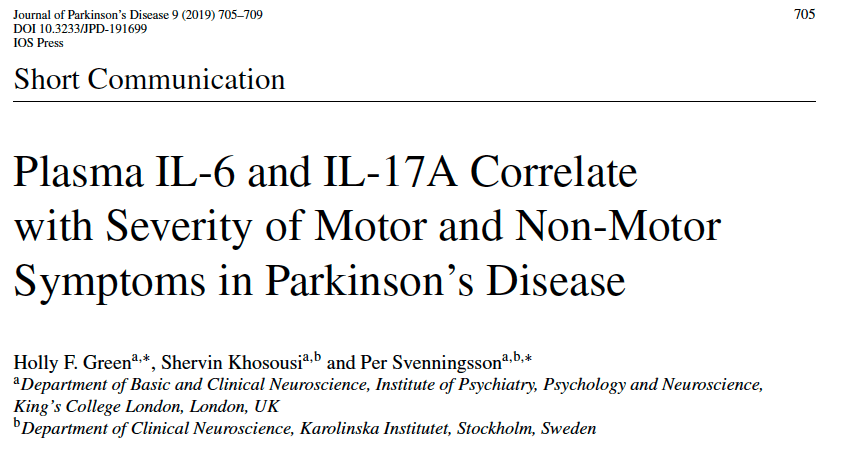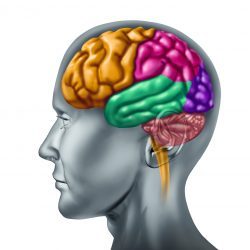“Do the difficult things while they are easy and do the great things while they are small. A journey of a thousand miles must begin with a single step.” Lao Tzu
“When I let go of what I am, I become what I might be.” Lao Tzu
Introduction: There are many ways that Parkinson’s begins. One of the several suggested etiology (causes) is neuroinflammation. The simplest definition is inflammation of the nervous system that is somehow activated by one or more processes, including infection, toxic injury, autoimmunity, or traumatic brain injury. The implication is that the ‘process’ is the initiator of the neuroinflammation. If you remove the initiation process, do you eliminate the neuroinflammation? If you reduce the neuroinflammation, what happens to the initiation process? Can you already see the vicious cycle that exists? I will stop here.
The work being discussed here is by Green, H.F., Khosousi, S. and Svenningsson, P., 2019. “Plasma IL-6 and IL-17A Correlate with Severity of Motor and Non-Motor Symptoms in Parkinson’s Disease.” Journal of Parkinson’s disease, 9: 705-709. They studied the levels of several cytokines including, interleukin-6 (IL-6) and interleukin-17A (IL-17A) in Parkinson’s compared to aged-match control samples, and their relationship with motor and non-motor symptoms. But first, a brief primer on inflammation.

“If you are depressed you are living in the past. If you are anxious you are living in the future.If you are at peace you are living in the present.” Lao Tzu
Definition and Purpose of Inflammation:
•Definition– It is important to begin by saying that the process of inflammation is a host defense response, which suggests it is there to help you not harm you. Inflammation is the reaction of living tissue and its blood vessels and blood/tissue cells to some kind of pathogenic insult. One of the results of inflammation is the generation of inflammatory mediators. These inflammatory mediators promote the movement of fluid and white blood cells both from blood and targeted tissues/organs into extravascular (outside the blood vessel) spaces and tissues.
•Purpose– The goal of inflammation can generally be summarized as follows: (i) localize or eliminate the cause of the pathogenic insult; (ii) limit tissue injury; (iii) remove or repair injured tissue components; and Iiv) restoration of normal physiology.
Okay, now you are probably thinking if all of this is a good thing, why then is neuroinflammation causing my Parkinson’s? The inflammatory and immune system together operate an incredible host defense response. However, if it is unleashed and not turned-back-down, the sustained inflammatory response begins to harm the host. Therein lies the problem, the over-stimulation, the inability the down-regulate the inflammatory response is likely partly responsible for the disease process of Parkinson’s linked to neuroinflammation.
“If you do not change direction, you may end up where you are heading.” Lao Tzu
•Acute inflammation
–Immediate reaction to tissue injury
–Rapid onset
–Innate immunity
–Neutrophil cell predominance
–Duration hours to weeks
–Prominent vascular response
•Chronic inflammation
–Persistent reaction to tissue injury
–Slow response
–Cell-mediated immunity
–Mononuclear cell predominance (macrophages, lymphocytes, plasma cells, monocytes)
–Duration weeks to years
–Less prominent vascular response
If they function as designed, the invading microorganism/substance is either destroyed or captured, and normalcy restored to that tissue-organ under attack. Think of inflammation as a two-edged sword, one face providing health and one face contributing to illness.
“He who knows that enough is enough will always have enough.” Lao Tzu
What are Cytokines? Cytokines are low molecular weight, soluble proteins that are produced in response to an antigen and function as chemical messengers for regulating the innate and adaptive immune systems.
•They are produced by virtually all cells involved in innate and adaptive immunity, but especially by T helper (TH) lymphocytes. Macrophages are also an important cell for both producing and reacting to various cytokines.
•The activation of cytokine-producing cells triggers them to synthesize and secrete their own cytokines.
•.The cytokines, in turn, are then able to bind to specific cytokine receptors on other cells of the immune system and influence their activity in some manner.

“From caring comes courage.” Lao Tzu
To describe the function of cytokines, think of this wartime scenario. You are a general, and your base camp is in the middle of enemy territory. To protect yourself, you’ve got scouts and these cells are called macrophages. And they patrol an encounter the enemy, pathogens, which could be bacteria, yeast, virus, fungi, damaged host cells/tissues, and strange substances that are indigestible. Your macrophages are essential inflammatory cells that will never retreat from trouble (pathogens). They synthesize and then secrete certain kinds of cytokines depending on what ‘type’ of enemy (pathogen) they encounter. Some of those cytokines may recruit inflammatory cells (acute or chronic) or immunologically related cells.
Your host defense mechanism is very powerful and it all revolves around the interaction of cells and cytokines responding to a known or unknown pathogen. And in reality, it’s much more complicated than the way I’ve described and depicted it so far. And it’s so fascinating scientifically and medically.
A Cytokine Storm: Cytokines are hugely crucial in directing cellular traffic, in responding to a pathological invasion, and they are amazingly powerful. Therefore, controlling their action may have some critical consequences in managing or a better understanding of our various disorders, like Parkinson’s. To give you an idea as to their complexity, and a challenge for me is simply how do you teach 190 medical students to learn about cytokines? To try to get them to understand, and to be aware of the power of the immune/inflammatory system that is regulated by cytokines. I have invented a few games for them to play, one was a puzzle on PowerPoint, and the snapshots below illustrate the game board. More importantly, this is an only small sample to the number of cytokines we synthesize, and it points out the primary system they regulate [innate immunity, adaptive immunity, chemokines (involved in cellular migration) and hematopoiesis (included in the synthesis of our blood cells)].

“Life is a series of natural and spontaneous changes. Don’t resist them – that only creates sorrow. Let reality be reality. Let things flow naturally forward in whatever way they like.” Lao Tzu
Plasma IL-6 and IL-17A Correlate with Severity of Motor and Non-Motor Symptoms in Parkinson’s . There is increasing knowledge about Parkinson’s and the complexities distinguishing the motor and non-motor symptoms. It is not as simple as we once thought. Part of the issue is that many of the non-motor symptoms go undiagnosed compared to the more easily seen and identifiable motor symptoms. What is becoming more apparent is that cytokine levels are increased in Parkinson’s, which suggests the role of the inflammatory/immune system in the pathogenesis of Parkinson‘s. What follows is a brief synopsis of this study.
- The major hypothesis being tested is there’s a relationship between certain cytokines and motor and non-motor symptoms in Parkinson’s .
- The methodology used to determine cytokine levels was quite impressive and it was highly sensitive single molecule array (SIMOA) technology.
- They evaluated 45 healthy controls and 66 Parkinson’s patients with well-characterized clinical scores with documented evidence of motor and non-motor symptoms.
- They measured the values for four different cytokines, including interleukin-6 (IL-6), interleukin-17A (IL-17A), tumor necrosis factor alpha (TNFa), and transforming growth factor beta (TGFb).
- Previous data has shown a role for IL-6 and TNFa in Parkinson’s.
- They found that IL-6 levels were positively correlated with motor scores and that IL-17A levels were correlated with the non-motor scores (specifically the mood and cognition related issues). TGFb was not correlated with either motor or non-motor symptoms.
- What they found was that the higher the IL-17A levels were associated with increased anxiety and depression scores in the Parkinson’s patients.
- A secondary strength of this study was that it confirmed recent data on IL-6 and TNFa.
- An interesting difference in their data was the.y found that IL-6 was more correlated with male patients and motor scores whereas the IL-17A levelsrelated to anxiety and depresssion in female patients.
- It is interesting to speculate that they found a relationship between two important, and very different cytokines, associated with motor (IL-6) and non-motor (IL-17A) symptoms.
- The data for IL-6 and IL-17A are associated with severity of disease, not how long they have had the disorder.
- A specialized T-cell makes IL-17A and it is called a TH-17 T-cell, which specializes in engaging the proinflammatory process as an important host-defense response.
- Not talked about in this paper, but my own speculation, is could levels of cytokine be used as a predictive measure of pending non-motor or motor symptoms? Much is still needed to better understand and appreciate this straightforward but interesting Parkinson’s research on cytokines.
“When you are content to be simply yourself and don’t compare or compete, everybody will respect you.” Lao Tzu
Cover Photo Credit: Image by RÜŞTÜ BOZKUŞ from Pixabay



I got chopped off before I was finished…..
I*m 75 years old, with diagnosis of PD 25 years ago, micrography and response to l-dopa being the main features. I do not have tremor.
I was very much taken with your references to golf, I still play, if that is the correct word.
Look forward to hearing from you
LikeLiked by 1 person
Michael, thanks for the note. Yes I still play golf, I find it very important for my therapy actually. The quarantine in North Carolina from COVID-19, Has given some restrictions on how we play golf but we still play. If you search my blog you’ll find many different posts on golf and how valuable I think it is for people with Parkinson’s. Best wishes, Frank
LikeLike